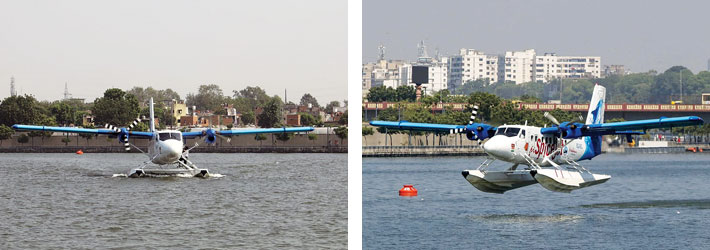INDIAN ARMED FORCES CHIEFS ON
OUR RELENTLESS AND FOCUSED PUBLISHING EFFORTS

SP Guide Publications puts forth a well compiled articulation of issues, pursuits and accomplishments of the Indian Army, over the years

I am confident that SP Guide Publications would continue to inform, inspire and influence.

My compliments to SP Guide Publications for informative and credible reportage on contemporary aerospace issues over the past six decades.
PM launches India’s first passenger Seaplane service
PM Modi took the first flight from Kevadia of Gujarat’s Narmada to Sabarmati Riverfront in Ahmedabad, marking a significant boost to regional aviation

Prime Minister Narendra Modi inaugurated a seaplane service on October 31 between the Statue of Unity near Narmada district and Sabarmati Riverfront in Ahmedabad. Modi launched the service aboard a twin-engine plane from pond-3 close to Sardar Sarovar Dam.
The Water Aerodrome at Kevadia and the seaplane Service connecting Statue of Unity in Kevadia of Gujarat’s Narmada district with Sabarmati Riverfront in Ahmedabad was launched along with the Water Aerodrome in Sabarmati River front in Ahmedabad and the seaplane Service from Sabarmati Riverfront to Kevadia. These are part of a series of Water Aerodromes being planned to bring the last mile connectivity, stated the press release from the Prime Minister’s Office. The launch of the nation’s first commercial seaplane service, marked the 145th birth anniversary of Sardar Vallabhbhai Patel.
The seaplane is reportedly a Twin Otter 300 registered in the name SpiceJet Technic and the service is operated by Spice-Jet’s subsidiary Spice Shuttle. SpiceJet will be using Twin Otter 300 seaplanes, built by plane maker De Havilland Canada. The low-cost carrier of India, SpiceJet, is said to have approval of 18 seaplane routes and this is one of them.
Inaugurated sea plane services between Ahmedabad and Kevadia. This service will boost tourism and help the local economy. pic.twitter.com/KWpF9tXAXA
— Narendra Modi (@narendramodi) October 31, 2020
The 19-seater seaplane is expected to be used for flights between the Sabarmati riverfront and Sardar Vallabhbhai Patel’s Statue of Unity in Kevadia as a part of Regional Connectivity Scheme. The seaplane will be able to accommodate 12 passengers and the all-inclusive one-way fare is reported to begin from 1,500 and go up to 5,000 under the UDAN scheme. The seaplane tickets are available for booking on www.spiceshuttle.com. The airplane will take about 45 minutes to cover the 200 kilometres aerial distance between Ahmedabad and Kevadia.
“We only need water bodies like rivers and lakes to start such services. We are now planning to start seaplane service between Surat and Kevadia” said Ajay Singh, SpiceJet Chairman
The Gujarat government had earlier announced that it had signed an MoU (Memorandum of Understanding) with the Union Ministry of Civil Aviation (MoCA) and Airports Authority of India (AAI) in July this year to begin the first-ever seaplane service in Gujarat to provide seamless and affordable air connectivity from Sabarmati Riverfront, Ahmedabad to the Statue of Unity, Kevadia.
The launch of this seaplane also comes as an encouraging and significant boost to the regional aviation market. “It is a momentous day for civil aviation operations in India. The opening of seaplane service in Gujarat is a small but significant step which will unlock the potential of our domestic & international tourism,” said India’s Civil Aviation Minister, Hardeep Singh Puri.

Ajay Singh, SpiceJet Chairman, also said that the seaplanes would help improve regional connectivity which is an initiative that is being encouraged by the Indian government. This also comes without the high cost of building airports and runways, thanks to the planes being able to take-off and land both on small water bodies and short airstrips.
“We only need water bodies like rivers and lakes to start such services. We are now planning to start seaplane service between Surat and Kevadia. We are in touch with officials for the same and studying their suggestions,” said Ajay Singh.
SpiceJet has already got around 3,000 booking requests in two days, reportedly. “Majority of the booking requests belong to the Ahmedabad region. We will start giving them tickets from tomorrow when the commercial flight would commence,” Singh said.
Seaplanes have the ability to land and take-off from water thus offering access to areas that do not have landing strips or runways, noted the release statement. It further added, “Thus it can help in connecting the geographies/regions that have challenges owing to its topography and bring the remotest parts of India into the mainstream aviation network without the high cost of building airports and runways. These smaller fixed wing airplanes can land on water bodies like lakes, backwaters and dams, gravel and grass, thus offering easy access to numerous tourist spots as well.”





